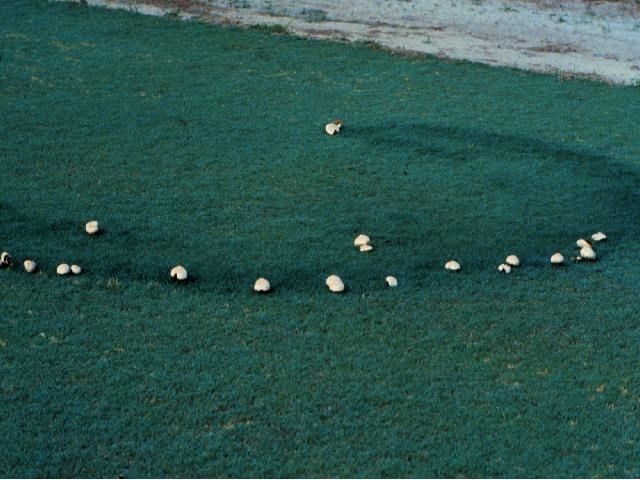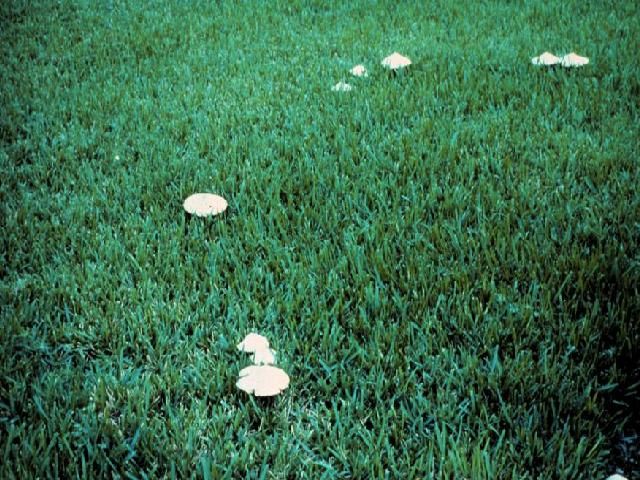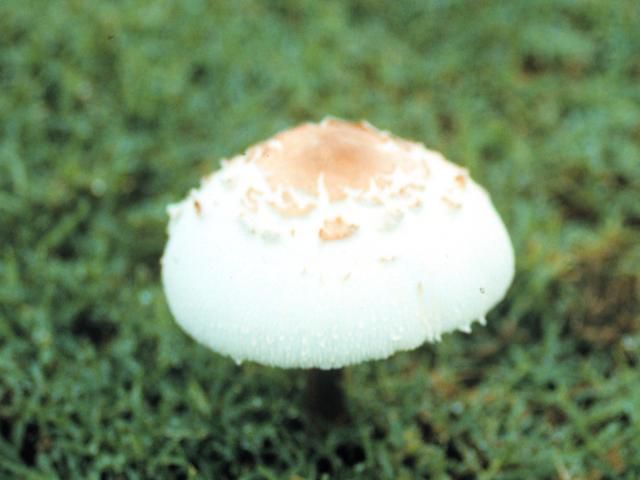Causal Agents: Fairy rings can be caused by multiple fungi including Chlorophyllum spp., Marasmius spp., Lepiota spp., Lycoperdon spp., and other basidiomycete fungi.
Turfgrasses Affected: All warm-season turfgrasses can be affected.
Occurrence: Fairy rings, especially the mushrooms, are most commonly observed during the summer months. It is during this time of year when Florida receives the majority of its rainfall. Fairy rings occur when large quantities of organic matter, such as lumber, tree stumps, and logs, are naturally located or have been buried in a lawn. The fungi are nourished and develop on this material. The mushrooms, which can be all sizes and shapes, are the fruiting stages of these fungi.
Symptoms/Signs: There are three types of fairy rings:
- Type I rings have a zone of dead grass just inside a zone of dark green grass. Weeds often invade the dead zone.
- Type II rings have only a band of dark green turf, with or without mushrooms present in the band (Figure 1).
- Type III rings do not exhibit a dead zone or a dark green zone, but a ring of mushrooms is present (Figure 2).

Credit: M. L. Elliott

Credit: M. L. Elliott
The size and completeness of the bands varies considerably. Rings may be very small initially, perhaps less than 1 ft, but they normally expand each year. It is not uncommon for rings to be 6 ft or more in diameter. Completeness of the ring can range from a quarter circle to a semicircle or full circle.
Mushrooms are normally produced during rainy weather. Some of the mushrooms (e.g., Chlorophyllum spp., Figure 3) are poisonous, so mushrooms should be removed or destroyed. Chopping them up with the mower is usually adequate. Further measures, such as collecting the mushrooms and disposing of them in the garbage, may be necessary if children or pets are present.

Credit: M. L. Elliott
Cultural Controls: If necessary for appearance purposes, dark green ring symptoms can be masked with nitrogen fertilizers. The rings will disappear naturally, but it may take up to five years. Although it is possible to excavate and fumigate the fairy ring sites, it is quite likely the rings will return if the food source for the fungi is still present underground.
In some situations, the fungi coat the soil particles and make the soil hydrophobic (meaning it repels water). This will result in rings of dead grass because the grass is being subjected to a very localized drought situation. If the soil under this dead grass is dry but the soil under healthy grass next to it is wet, then it is necessary to aerate or break up the soil under the dead grass (using a pitchfork). Then a soil-wetting agent can be applied and the ring (and only the ring) watered daily to rewet the soil and encourage turfgrass recovery.
Chemical Controls: Effective fungicides include azoxystrobin, flutolanil, metconazole, pyraclostrobin, and triticonazole.
Fungicides inhibit the fungus only. They do not eliminate the dark green or dead rings of turfgrass, and they do not solve the dry soil problem.
The UF/IFAS Extension Electronic Data Information Source (EDIS) website can be referenced for a homeowner's guide to turfgrass fungicides (https://edis.ifas.ufl.edu/publication/pp154). Fungicide labels indicate site application restrictions, as some fungicides cannot be used on residential lawns. Label directions and restrictions for all pesticides should be followed as required by law. Caution should be exercised, as DMI (demethylation-inhibiting) fungicides have shown the potential to damage bermudagrass turf. The presence of a fungicide on this list does not constitute a recommendation.
The "Turfgrass Disease Management" section of the Florida Lawn Handbook (https://edis.ifas.ufl.edu/lh040) can be referenced for explanations of cultural and chemical controls.